August 2, 2013
Air Date: August 2, 2013
FULL SHOW
SEGMENTS
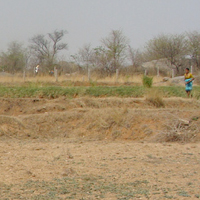
Climate Change and Conflict
View the page for this story
A new study in the journal Science quantifies a direct link between higher temperatures and increased conflict ranging from domestic violence to civil war. One of the lead researchers, Edward Miguel from UC Berkeley, tells host Steve Curwood that as world wide temperatures increase with climate disruption he expects to see more strife. (06:55)

Tesla Stock Soars
View the page for this story
Consumer Reports declares the Tesla S to be the best car it has ever tested, and the electric car company's stock is ten times higher than a year ago. Environmental writer Jim Motavelli specializes in green transportation and joins host Steve Curwood to talk electric cars. (06:30)
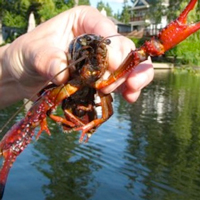
Invasive Crayfish
/ Ashley AhearnView the page for this story
The Red Swamp crayfish, native to the US south-east, are now firmly established in the Pacific north-west, and as Ashley Ahearn reports, they threaten to outcompete the local blue Signal crayfish. (04:50)
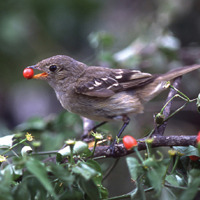
Science Note: Best To Be Eaten
/ Erin WeeksView the page for this story
A new study finds that seeds that pass through the digestive tract of a bird may be more likely to avoid fungal infection and predation by ants. Erin Weeks reports. (01:50)
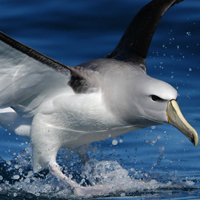
Russia Nixes Antarctic Marine Reserve
View the page for this story
Representatives from the countries that govern Antarctica recently met in Germany to create a massive marine reserve in the seas around the icy continent. At the last minute, Russia pulled out of the deal. Steve Curwood discusses the implications with ocean conservationist Carl Safina. (06:30)
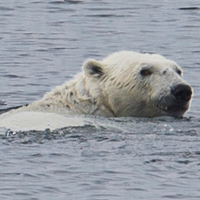
Swimming Polar Bear
/ Mark Seth LenderView the page for this story
Shrinking sea ice in the arctic is threatening the survival of polar bears. But writer Mark Seth Lender came across one polar bear that was very much a survivor. (03:30)
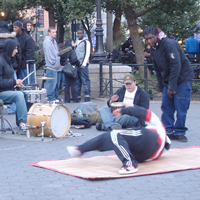
Hip Hop Born in the Parks
View the page for this story
It’s summer time, and for city folks that can mean heading to the park to get together with friends. Grist contributor Ben Adler tells host Steve Curwood that open spaces like Manhattan’s Union Square park saw the emergence of the musical genre hip hop. (07:20)
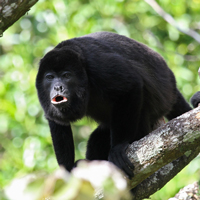
Recording Nature By Sound
View the page for this story
New computer software can sift through thousands of hours of nature recordings to identify and map individual species. Mitch Aide, a researcher at the University of Puerto Rico, tells host Steve Curwood about how his team devised the systems and put them to work. (06:50)
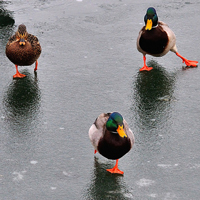
BirdNote® All That Jazz
/ Mary MaCannView the page for this story
From penguins to ducks to larks, birds have served as an inspiration to many jazz composers, as Mary MaCann reports in today's BirdNote. (02:20)
Show Credits and Funders
Show Transcript
Host: Steve Curwood
Guests: Edward Miguel, Jim Motavalli, Carl Safina, Mitch Aide
Reporters: Ashley Ahearn, Erin Weeks, Mark Seth Lender, Mary McCann
[THEME]
CURWOOD: From Public Radio International, this is Living on Earth.
[THEME]
CURWOOD: I'm Steve Curwood. A new study charts the links between hotter temperatures and violence - the collapse of the Mayan Empire provides a cautionary tale for us today.
MIGUEL: So really throughout the world a number of major civilizations have met their end following adverse climate. And I think that's something we need to be very aware of as we look forward to the predicted global warming over the next half century.
CURWOOD: The danger of increased violence and civil war if we don't control the rising mercury. Also invasive red crayfish in the northwest may drive out the lovely locals altogether.
OLDEN: Take a look at the blue color on that. So these are olive brown on the top of them and then you flip them over and they’ll often have this blue tinge and a red on the underside of their claws. Just a gorgeous color.
CURWOOD: But if you can't beat them, some say eat them. That and more this week, on Living on Earth. Stick around.
[NEWSBREAK MUSIC: Boards Of Canada “Zoetrope” from “In A Beautiful Place Out In The Country” (Warp Records 2000)]
ANNOUNCER: Funding for Living on Earth comes from Stonyfield Farm, makers of organic yogurt, smoothies, and more.
Climate Change and Conflict
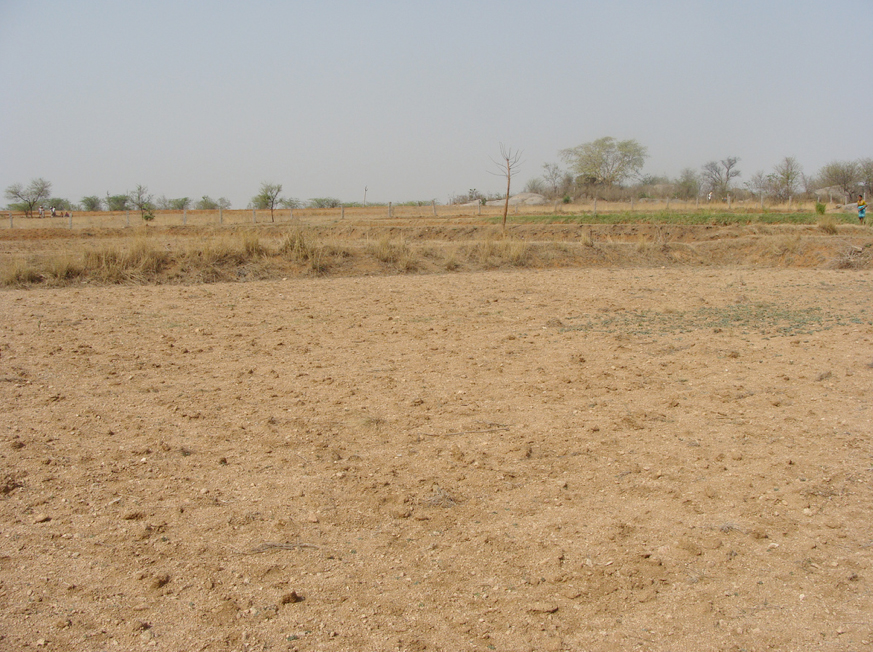
Persistent drought and crop failure can lead to large scale conflict in developing countries that rely on subsistence agriculture. (Ben Sutherland)
CURWOOD: From the Jennifer and Ted Stanley Studios in Boston, this is Living on Earth. I’m Steve Curwood. As global temperatures rise, so do the levels of domestic violence, crime and armed conflict, according to the journal Science. Decades ago Thomas Homer-Dixon linked conflict in poor countries to scarcity of water and croplands. There were many other studies, but none quantified how global warming might affect conflict over the entire planet. Now a meta-study, that delved into more than 60 previous studies from a variety of disciplines, has found just how much more violence is linked to increased warming. Co-author Edward Miguel, an economics professor at the University of California, Berkeley, explains.
MIGUEL: Our study in Science examines a range of other studies that have looked at the relationship between climate and violence. And we look at violence on a range of scales, everything from crime rates in the US all the way up to Civil War in Africa and crime in other parts the world. And the main conclusion of the study is we find a very strong relationship in periods of extreme climate, like very hot temperatures like the heat wave going through Europe this year, for example, we find increases in violence, violent crime, civil war, riots, and it’s a very robust relationship.
CURWOOD: Please give me a recent example of a place where crime or violence increased with increased temperature.
MIGUEL: Definitely. There's been a lot of research recently on the link between hot temperatures and violence in sub-Saharan Africa. That's a region that's my own personal research focus. There are findings showing that in periods of very high temperatures and also low rainfall, there’s an increase in civil war risk, there's an increase in rioting and other forms of political instability. Sub-Saharan Africa is a region that already has a very high baseline rate of political instability, so increased warming like the order of 2°C could increase that to very, very high levels of violence.
CURWOOD: How about the United States?
MIGUEL: We also looked at studies that look at crime in United States, and so if you look at cities, for instance, that have anomalously high temperatures in a given month, they tend to have more violent crime, more murder, more assault.
CURWOOD: What about India? In recent years there have been some searing heat waves there. What results have you seen there?
MIGUEL: Yes, there are also studies from India. There's a fascinating recent study that looks at violence at a different scale. They look at domestic violence, and they find that in regions that are experiencing very hot temperatures, you see a rise in domestic violence against women. You know this is obviously a very tragic finding, and it really illustrates that this link between high temperature and violence holds at all different scales from within the home to the streets of our cities all the way up to society wide civil war.
CURWOOD: So, tell me about the quantifiable data you have that links crime and temperature increase.

Edward Miguel (far right) is the Oxfam Professor of Environmental and Resource Economics in the Department of Economics at University of California, Berkeley. (Edward Miguel)
MIGUEL: Yes. There's actually two sets of numbers, so the first thing we did is conceptually divide up the data sets into those data sets that look at group level violence, like civil war or rioting, and then we separately looked at violence that we call interpersonal violence, and those are mainly the crime data sets. And just to give you a sense of what the magnitudes are, the estimated average effect of 2°C warming in tropical Africa on the risk of civil war in Africa would be something on the order of 40 to 50 percent increase in the risk of civil war.
CURWOOD: What about a 2°C rise in temperature regarding domestic or personal violence?
MIGUEL: So when we look at that number, the magnitudes aren’t as large, but they’re still statistically significant. So a rise of 2°C in temperature in the United States would be associated with something like a five or six percent increase in violent crime in United States. Now, if you count up the total number of violent crimes that would lead to, we’re talking about many, many thousands of additional violent crimes in the United States each year.
CURWOOD: So why do you suppose this trend is so predictable everywhere around the world?
MIGUEL: You know, there's a number of different reasons. There's two main mechanisms or channels that scholars have written about. One is a fundamental - you could think of it as a physiological channel - which is at higher temperatures people become more aggressive. Now there’s a second set of explanations that are very important in low income regions of the world like in South Asia or Sub-Saharan Africa or parts of Latin America. Most people are engaged in agriculture - subsistence agriculture - and they don't typically irrigate their crops. So when the when the rains fail and crops fail, people lose their income and become desperate. And that's a very plausible explanation in our view for why you see a rise in organized political violence in, say, African countries following a drought.
CURWOOD: What interest has the military and intelligence community had in your research?
MIGUEL: They’ve been very interested in this is as a national security issue. So if you think back to some of the critical parts of the world for US foreign policy, whether there in the Horn of Africa or whether it's in South Asia, like Pakistan, those are parts the world where the relationship between high temperatures and violence is very well-documented, and the military command is quite concerned that rising temperatures will be lead to even more political instability.
CURWOOD: Ted Miguel, this trend is nothing new. You also looked at ancient civilizations in your research. Can you tell me about that?
MIGUEL: What we found is a very strong link between extreme climate historically and civilization collapse. The classical Maya civilization in the Yucatán that between 800 and 900 A.D. they experienced multiple multi-year mega-droughts and at the end of the third of those mega-droughts, the civilization collapsed, never to recover its previous glory. There are similar findings in China - several Chinese dynasties have also collapsed. So really throughout the world a number of major civilizations have met their end following adverse climate. And I think that's something that we need to be very aware of, as we look forward to the predicted global warming over the next half-century.
CURWOOD: Climate scientists generally agree we’re looking at least an average temperature rise of 2°C over the next 50 years or so. That’s a little less than 4°F. What is that say to you in terms of our ability to adapt and continue to get along with each other?
MIGUEL: That's one of the the million dollar questions lurking in the background, is over the next 30, 40, 50 years, if temperatures do increase globally 2°C, how much will societies be able to adapt to those changes? So for instance will police forces in the US start recognizing this link between high temperature and violence and do something about it? Or will there be new crop varieties developed for India or Africa, that are more drought resistant? If we look historically, however, we find that there's typically been quite limited adaptation to climate changes, so we very much think that further investments and policy changes around adaptation are a key priority, to make sure that we don't suffer all the violence that our paper predicts could occur with the temperature rise.
CURWOOD: Edward Miguel, an economics professor at the University of California, Berkeley. Thanks for taking the time with me today, Ted.
MIGUEL: Thanks, Steve.
Related link:
Quantifying the Influence of Climate on Human Conflict
[MUSIC: Marco Benevento “Fireworks” from Escape Horse (Promo EP) (Royal Potato Family 2012)]
Tesla Stock Soars

Tesla Model S ( Photo: Tesla Motors)
CURWOOD: The electric car market is suddenly booming, and the big automakers can’t seem to get to market fast enough. BMW is among the latest to jump in, joining GM, Ford, Chrysler, Nissan and Honda, among others. But if the checkered flag were to come down right now in this race, the trophy would go to Tesla Motors, started by entrepreneur Elon Musk. Consumer Reports named the Tesla S the best car they’ve ever tested, and the company's stock price is about ten times higher then it was a year ago. Jim Motavalli is an environmental writer who specializes in green transportation. Welcome to Living on Earth, Jim.
MOTAVALLI: It's great to be on, Steve.
CURWOOD: So, Jim, why do you think investors are so excited about the Tesla?
MOTAVALLI: Well, it’s something entirely new. We've seen electric cars pretty much as good enough cars, with only about 100 miles of range which cause range anxiety, and the performance was nothing to write home about, and storage space was compromised by the batteries. Almost none of that is an issue with the Tesla model S. You get lots and lots of space in the front and the back. You get an amazing amount of passenger room including two jump seats. You can actually put seven people in the Tesla model S. It's incredible looking, and it's very, very fast. It goes like the proverbial bat out of hell. It’s just amazingly fast - what is it, five or six seconds, 0 to 60? And then there's that 300-mile range, which admittedly you have to buy the top line 85 kilowatt-hour battery to get. If you talk to Elon Musk he’s always said that what he wanted to do was build a car that was better than a gas car, and I think in many ways he has done that with the model S.
CURWOOD: So, what’s the catch, Jim?
MOTAVALLI: The catch is that they’re pretty expensive. $60,000 to $100,000.
CURWOOD: Whoa. So who buys these things?

Tesla S on the road (Photo: Tesla Motors)
MOTAVALLI: Well, I would say it’s your upper-middle class and upper-class citizenry, people who love new technology, early adopters, people like that. Also, very green people I think have been buying them. We may run out of people who are both very green and have lots of money fairly soon, I'm not sure. But the company has not been standing still. It's coming out with a lot of new things, like very fast charging. It's expanding its supercharger network all across the country. They’re coming out with new models, including an SUV that's gonna be on the Model S platform. They just announced that they’re going to do battery swapping. And down the road is a much more affordable Tesla that’s supposed to be in about the $30,000 range.
CURWOOD: Tell me about the size of this battery? People talk about hooking electric cars up to their house? What could this do for my house if I could power my home with it?

Nissan Leaf (Photo: Nissan USA)
MOTAVALLI: Well, I think that we will see that kind of application very soon. Nissan already has the kind of thing. It's called V2G, or vehicle-to-grid. And there are some experiments going on at the University of Delaware where they’re looking at having electric cars feed power back into the grid. And it really is more effective if you have a bunch of cars doing it at the same time which is what they're sort of working on there. And certainly you would be able to get payments amounting to about $5 or $10 a day from your utility company if you allow it to draw power from your car. Basically the idea is that if there's enough cars there it means I don't have to fire up another power plant and they save enormous amounts of money so it's worth paying you a little bit to have your car accessible when it's charging.
CURWOOD: $10 a day? Well, that would help with a $300 a month car payment. I suspect the Tesla’s a way bigger number than that.
MOTAVALLI: Yes, and I don’t know whether the people that buy Teslas really need $5 a day, but it’s interesting that it’s out there.
CURWOOD: So how are the other electrical companies faring?

The Tesla S visited by Jim Motavalli (photo: Jim Motavalli)
MOTAVALLI: Well, the first year...if you say 2012 was really the first full year of electric vehicle production and maybe 50,000 of them were sold in the US, which is not a big number...it’s less than half of one percent of all the vehicles sold and I would say 2013 will probably have 80,000 sold. So its progress is not a huge amount. I think one of the things that's driving the market right now is very low-cost battery and electric vehicle leasing. You can get a car for $199 a month and that’s just a good deal. From Honda, from Nissan, from Chevrolet, they’re all offering $199 leases. One of the reasons automakers are very keen on selling electric cars is they need to meet the California zero mission vehicle requirements which are starting to ramp up.

BMW’s electric i3 in a showroom in New York (photo: Jim Motavalli)
CURWOOD: Explain the California rules for those who may not be so acquainted.
MOTAVALLI: Well, if you look at the federal rules, all it requires is the automakers to reach a certain fuel economy target. So you don't have to do that with electric cars, but California really has actual quotas for electric cars. They have to make a certain number of them. And it’s never been clear to me whether they have to produce them or also sell them, because you can't really mandate that people buy cars, but that is basically the mandate. They want a certain percentage of electric vehicles on the road by certain dates. And as I mentioned, it ramps up. By 2025, they’ve got to be pretty seriously into this if they want to sell cars in California. And right now I believe it's about 38 percent of all the EVs sold so far have been in California, so that is by far the biggest market in the US.
CURWOOD: So, Jim, what will it take for us to see more electric cars on the US roads?

Jim Motavalli (photo: Mary Ann Masarech)
MOTAVALLI: Well, I think that more people have to be aware that they’re available. That’s kind of a problem right now. The auto companies are starting to do a lot of advertising and awareness campaigns. I think people are pretty well aware that there's hybrid cars on the market. They’re probably a bit unclear as to what a plug-in hybrid is and the fact that there’s a number of battery electrics available now, I think a lot of people aren’t quite geared up to that yet. It takes a while. I mean, if you look at what happened when we switched from the horse to the horseless carriage, it didn't happen overnight and there was both of them on the road for a long time. I think if we are looking at a transition to the electric car, it’s not going to happen really quickly. I think looking ahead to the next 20 years, there’s still going to be gas cars on the market, maybe even 30 years.
CURWOOD: Jim Motavalli is an environmental writer who blogs for the New York Times. Thanks so much for joining us, Jim.
MOTAVALLI: It was great to be on.
Related links:
- More about Tesla
- More about Jim Motavalli
[MUSIC: Mike Castro De Maria “Car Groove” from Sweet Sugar Lounge (Supersonique Studio 2011)]
CURWOOD: Coming up...Mark Seth Lender and a swimming polar bear. That's ahead on Living on Earth.
[CUTAWAY MUSIC: Ernest Ranglin: Bourbon Street Skank” from Below The Bassline (Island Records 1996)]
Invasive Crayfish

(Photo: Ashley Ahearn)
CURWOOD: It's Living on Earth, I'm Steve Curwood. If you're a fan of Gulf Coast cooking, you probably love gumbo and jambalaya. But those spicy delights are hardly the first thing you'd expect to find on menus in the temperate Pacific northwest. That could be about to change though, as the invasive red swamp crayfish is now being found in some lakes in the northwest. The crayfish, or crawfish, or crawdad, is a native of the southeastern US and the Gulf coast, and notably delicious. Ashley Ahearn of the public media collaborative EarthFix, has been investigating.
[KIDS PLAYING OUTSIDE]
AHEARN: About 20 miles east of Seattle you'll find Pine Lake. It's a small body of water, only about 40 feet deep and lined with well-kept homes. Yellow labs patrol green lawns and sunny docks. Bass and trout fishermen share the water with laughing kids on paddleboards.
[JAWS THEME MUSIC]
AHEARN: But beneath the surface‚ down in the depths of Pine Lake.
OK. OK. No sharks here. But there's a new creature on the block‚ with really big claws.
OLDEN: This is called the red swamp crayfish.
AHEARN: Julian Olden sits in a canoe on Pine Lake. He pulls a flailing red crustacean out of a trap and holds it gingerly as it waves its claws around.
OLDEN: If they pinch you they hang on for a little while.
AHEARN: This spoken from experience?
OLDEN: Yeah you have to convince them to let go but you can grab them right under their arms like that‚
AHEARN: Olden is a freshwater ecologist with the University of Washington. Over the past several years he’s been setting traps around this lake to monitor the advance of these aggressive intruders. He puts the red crayfish down and it scuttles around the bottom of the canoe, dangerously close to his bare toes.
OLDEN: It's about 4-5 inches length total, so that's what you'd expect to see.
AHEARN: Olden says these intruders could be changing the native ecosystem. The red swamp crayfish eat tadpoles, bass and trout eggs. They also munch through the plants that line the bottoms of lakes like this one.
OLDEN: And by basically being an underwater lawnmower they're removing the home and cover for a lot of those native fish.
AHEARN: You might call Pine Lake ground zero for the red swamp crayfish invasion. A biologist discovered them here in 2000. They've since shown up in nine other lakes in Washington. Wildlife managers have also reported them in a few places in Idaho and the Willamette River.
OLDEN: So we're just going to head over to this bay.
AHEARN: This wasn't natural colonization. In at least one instance, these crayfish were intentionally released after being used for research or as classroom pets. But on this lake anyway, the red swamp crayfish have been met with some local opposition. Olden pulls up another trap and out plops a member of the home town team‚ a Signal crayfish.
OLDEN: Take a look at the blue color on that. So these are olive brown on the top of them and then you flip them over and they all have this blue tinge and a red on the underside of their claws. Just a gorgeous color.
AHEARN: Signal crayfish have lived in this region for the past 10,000 years or so. But Olden's research has found that at Pine Lake anyway, they've been overtaken by the red swamp crayfish.
The blue-shelled locals don't breed as often as their crimson competition, and when they do, they don't produce as many offspring. They also prefer cooler temperatures so in the future, things may not look good for them. For now anyway, they're getting some help in the fight.
OLDEN: Hey Renee how are you?
AHEARN: Renee Henderson and her daughter Solana are among 40 or so homeowners on Pine Lake who are working with Julian Olden to trap the invasive crayfish. At eight-years-old, Solana is one of the lead trappers. She crouches down on the dock and hugs her knees as she talks to us.
OLDEN: You were just telling me about the big whopper of a crawfish that you caught. How big was it?
SOLANA: It was 69.
OLDEN: 69mm long?
AHEARN: Do you know how many you've caught?
SOLANA: I pretty much don't know because we’ve got a lot and that’s all.
AHEARN: If you were going to estimate‚ would you say 100 or 200 - or 20?
SOLANA: I would say 48.
[LAUGHING]
HENDERSON: We've done a lot of googling recipes for crawfish pie, crawfish boil. It’s been good for her just learning about the environment and how to protect it. She’s obviously into science.
AHEARN: All the participants in Olden's study keep data sheets tallying up how many crayfish they catch, and what the breakdown is between red swamp crayfish and the native Signal crayfish. So far this year Pine Lake residents have trapped and removed around 500 red swamp crayfish. Olden says some years they’ll catch upwards of 800 of them.
OLDEN: You know on days like this with all these people with traps in the water you’re pretty inspired, knowing that hey we might have a chance - not to remove them‚ eradicating them is pretty much impossible - but controlling them to low enough level where their impacts are minimized, that's what we hope will happen over the next couple years.
AHEARN: Olden also hopes that this model of local engagement can be replicated in other lakes where the invasive red swamp crayfish has staked its claim. I'm Ashley Ahearn on Pine Lake.
CURWOOD: Ashley reports from the public media collaborative EarthFix. For photos, scuttle off to our website, LOE.org.
Related link:
Earth Fix
[MUSIC: James Andrews “The Treme Shuffle” from The Big Time Stuff (James Andrews Music 2011)]
Science Note: Best To Be Eaten

The small-billed elaenia dines on the fruit of common chili peppers—and primes their seeds for success, according to a new study. (Photo: Joshua Tewksbury)
CURWOOD: In a minute, hopes for a massive new marine reserve hit a rock. But first this note on emerging science from Erin Weeks.
WEEKS: In the animal kingdom, getting eaten usually means game over. But for seeds, getting gobbled up may just be the best thing that can happen to them. Researchers from the University of Washington found that seeds that passed through the gut of a common South American bird were almost five times more likely to survive.

Scientists looked at a chili pepper related to this species to test the benefits to seeds of being gut-processed. (Photo: Dik Leffner)
It’s well established that birds and other fruit-eating animals play a critical role in dispersing seeds far from parent plants - but this study provides the first solid evidence of two other surprising benefits birds provide.
The scientists studied chili pepper seeds that were digested by the small-billed Elaenia, a gray flycatcher found all over South America. When they looked at seeds the birds had eaten versus those that were undigested, they found striking differences.
First, digested seeds were only half as likely to be infected and killed by fungus. And second, digested seeds emitted 100 times less of the aromatic chemical compounds that can attract seed-eating ants.
It’s as if traveling through the intestinal tract of a bird “cleaned” the seeds - boosting their protection from traditional predators and giving them a greater chance to germinate into the next generation of chili plants.
Together, the effects add up to a substantial boon to the chili - and, researchers suspect, many other plants as well. All it takes is a trip through the guts of a bird.
That’s this week’s note on emerging science. I’m Erin Weeks.
Related links:
- The open-access study in the August edition of Ecology Letters
- University of Washington’s press release
Russia Nixes Antarctic Marine Reserve

An albatross coming in for a landing (photo: Carl Safina)
CURWOOD: The 25 countries that cooperatively govern the seas around Antarctica met recently in Germany to discuss the creation of a massive marine protected area beside the continent. But at the last minute, the Russians pulled out of the deal, much to the dismay of ocean conservationists. Carl Safina of the Blue Ocean Institute is a scientist and award-winning author of many books about the oceans. He joins us now to discuss what derailed plans to double the world's marine reserves.

Carl Safina (photo: Pat Paladines)
SAFINA: This is just silly. The Russians simply said that they believe that this treaty body doesn’t have the authority to create marine reserves when they clearly do, and they have in the past. So they didn’t seem to really honestly raise whatever concern they had or whatever was stalling them. I think it was just that they didn’t want to be honest, and I think to be honest, they simply wanted to continue fishing in a place where the rest of the world wanted to project what’s there.
CURWOOD: So the Russians have said ‘???’ to having a marine protected reserve. What’s the extent of Russian fishing down there? I mean, why would they pull out of this?
SAFINA: It’s not a lot right now, apparently. But I guess they just don’t like the whole idea. And I suspect there’s something larger afoot, which is, they are trying to put a big chill on the whole idea of creating protected areas in international waters, because they’re also eyeing parts of the Artic Ocean that are melting to try to extend their claims there. I had not read that in any of the material about this, but I do suspect that’s part of it and probably why they didn’t come up with an objection that made sense or seemed honest.
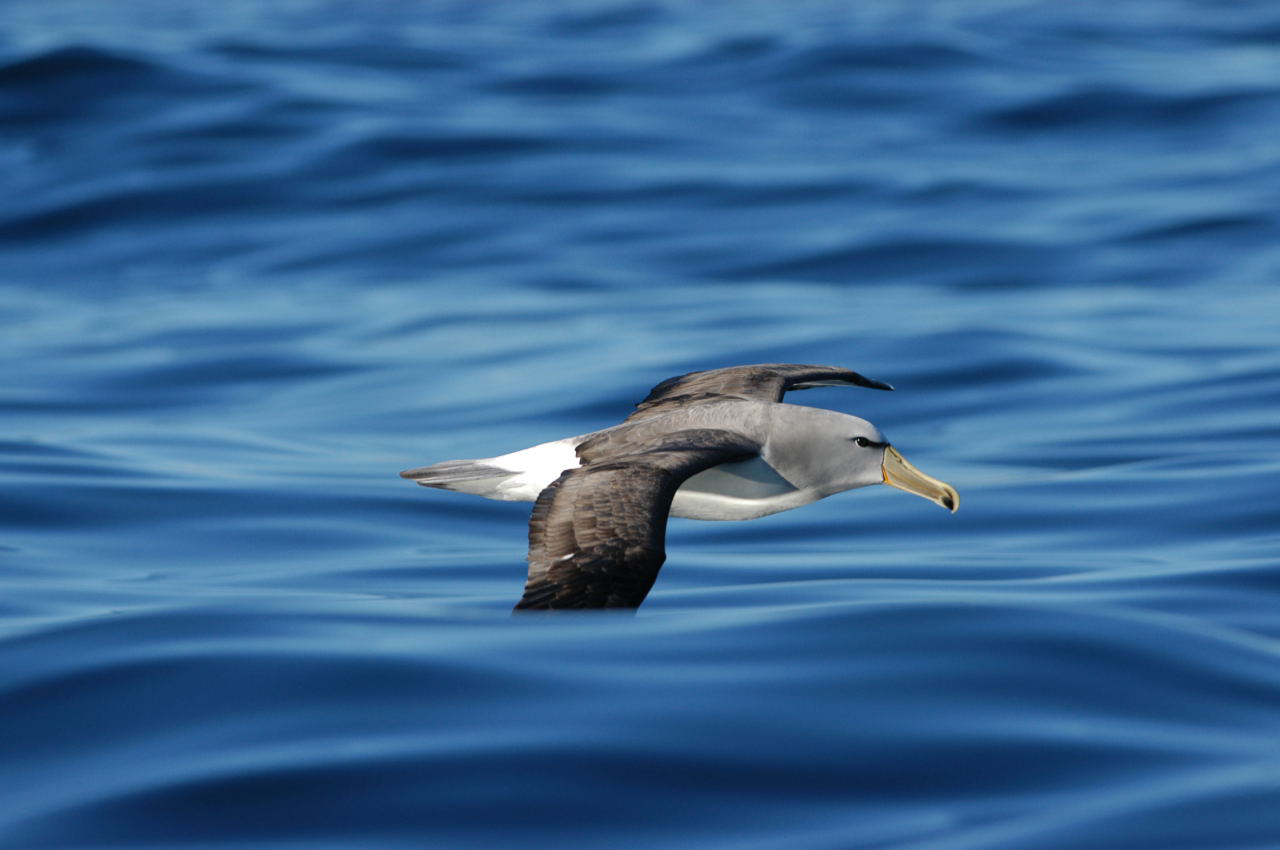
Fishing in Antarctica has been damaging to many seabird species like the albatross (photo: Carl Safina)
CURWOOD: Where was this marine reserve intended to be, and how big was this supposed to be?
SAFINA: Mainly in the Ross Sea. It was supposed to be 1.6 million square kilometers within a larger 2.3 million square kilometer protected area, and then part of it totally protected from fishing.
CURWOOD: What exactly is there that needs protection?

The toothfish, or “sea bass” found in the seas around Antarctica are endangered from overfishing (photo: Apcbg)
SAFINA: Well, there are these very big fish called Toothfish that can weigh over 100 pounds. They are marketed as Chilean Sea Bass, which is not really their real name. And they have been very depleted, so they need protection. The whales were pretty much demolished in the 20th century; they need protection from continued hunting by Japan. And what the whales eat is krill, which is also what the penguins eat, and that needs protection as well, even though there’s a lot of it, it is so crucial to the basis of the food chain. All the penguins, all the whales, most of the fish, all the seals all eat the same thing, and as the waters there warm up it has been a problem for the krill.
CURWOOD: Now, krill, as I understand it, Carl, is often used to make omega-3 supplements that people take for dietary reasons. How much is the krill under Antarctica under pressure because of the demand for omega-3?
SAFINA: The amount of pressure varies from place to place. It’s been sort of patchy, but that’s not really the big thing. The big thing is catching it to feed to pigs and chickens, and then finding a good or palatable way to turn it into food for people, in which case the floodgates would just open up on it. The other thing about the fishing down there is that a lot of the fishing kills seabirds that are not intended to be killed, like Albatrosses, Shearwaters, Petrels and things like that. And in the case of the Albatrosses, and some of the Petrels, it’s killed enough of them to drive their populations down quite far and endanger their future.
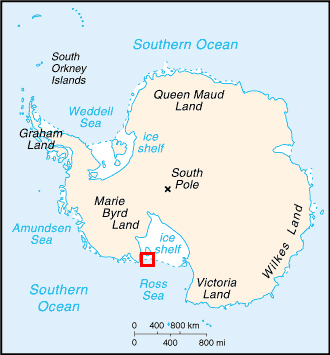
Much of the territory that would have been preserved is in the Ross Sea (photo: CIA World Factbook)
CURWOOD: How does it do that?
SAFINA: Well, when the boats are towing nets, these birds come around because there’s always something spilling out of the nets, and they strike a wing on the net cables, and those birds are supposed to live a long time. Many of them can live to be 50-years-old. And if they’re playing a very dangerous game as a major part of their lifestyle, then it’s very dangerous for them.
CURWOOD: How important are these marine protected areas?
SAFINA: Well, I think they’re very important, though they won’t solve every problem in the ocean. They don’t solve the warming problem. They don’t solve the problem of acidifying water. They don’t solve all of the overfishing. But in each case, they let the ocean be more resilient by letting it build up populations and animals that can either respond to these stressors or can sort of go forth from the protected areas and contribute to the fishing. It’s a little bit like trying to live out of your checking account - you will run out of money. But if you put some of your money in a savings account, and it bears interest - well, although these days that analogy is not very convincing - but if it can bear interest, that’s like a marine reserve which is an interest-bearing savings account.
CURWOOD: What’s the overall impact on overfishing on the ocean’s ecology?
SAFINA: Well, we’re actually affecting the way that evolution is going in the ocean by putting so much pressure on species. For instance, we are selecting for the miniaturization of wild fish because the individuals that are geared to grow more before they mature and reproduce usually don’t get a chance to reproduce, and the ones that grow less before maturing and reproducing have more of a chance of reproducing. So we’re selecting for the smallest fish on that range. And laboratory studies have shown that if you do that consistently, in only four generations you get a genetically based miniaturization of the entire population.
CURWOOD: The Commission for the Conservation of Antarctic Marine Living Resources gathers again in October. I imagine they’ll look at this question once more. What advice do you have for the parties getting together?
SAFINA: Well, I have the luxury of being a biologist, not a diplomat, so I would say to Russia, please grow up, and I would say to everybody else, please apply more pressure.
CURWOOD: Carl Safina is an environmental scientist and an award-winning author of many books about the world’s oceans. Thanks so much for taking this time, Carl.
SAFINA: Always an honor and a pleasure. Thank you so much, Steve.
Related links:
- More about the Commission for the Conservation of Antarctic Marine Living Resources (CCAMLR)
- Carl Safina’s organization is the Blue Ocean Institute
[MUSIC: Bill Frisell “The Big One” from Big Sur (Savoy Jazz 2013)]
Swimming Polar Bear

(Mark Seth Lender)
CURWOOD: The breadth and depth of arctic sea ice is rapidly diminishing, and the reality of the threat to polar bears is growing almost daily it seems. In early July of this year, Mark Seth Lender joined Adventure Canada in Hudson Strait and found a polar bear swimming along the floe edge. The encounter was not what he, or maybe the bear, expected.
LENDER: There is a polar bear swimming through the slush at the edge of the floe. This year’s ice and last year’s ice and the porous remnant of a berg. All that melt, dispersed, makes the sea air cold. The bear, only head and face and sometimes the highpoint of his backbone above water looks cold although he is working too hard for that, trying to get away, from us. Seeing this, Gunnar Roos, the ship’s Master, cuts his engines to dead slow so there is more drift than way. To give him room. The bear… speeds up. He looks back, and his lips part in a low growl we cannot hear for the idling of the screws and the steering gear and the floebergs scrapping the steel of the hull. He turns into a channel in the ice, and disappears.

(Mark Seth Lender)
There he is again much closer. We’ve veered off, changing course; but the bear has changed course also and come out the wrong way - toward us. Now in his mind he is sure. We are after him. He is going to die. He sneers, and paddles on, faster and harder.
He is making five knots, maybe six, which seems an impossible speed and the wake breaks out behind him 40 meters in a widening V. It is too much. Even for a polar bear (who can swim without drowning 300 nautical miles). It is all being spent, right here.

(Mark Seth Lender)
The polar bear cannot give up, will not part from his will to survive, it is not in him. Nor is it in him to continue like this. In a last gambit he breaks stride and kneeing up like a child at a chair that is too high, clambers onto a flat of ice, the sea pouring out of his hair. Water cascades from his face, the underbelly and swaying paws as he half walks, half runs. Then slows…. and looks…and comes to a stop. He stands broadside to our retreating ship, the dark skin showing through beneath the saturated white of him. And his head comes up, and follows as we head away and knows that he has won.
His rest is brief and all he needs, and he clambers slowly back into the sea as polar bears have always done and swims, away, from our small sample of humanity and into the brash ice, and beyond, until he vanishes among the icebergs that are white and blue as clouds on a fragile… glass… blue… sky.
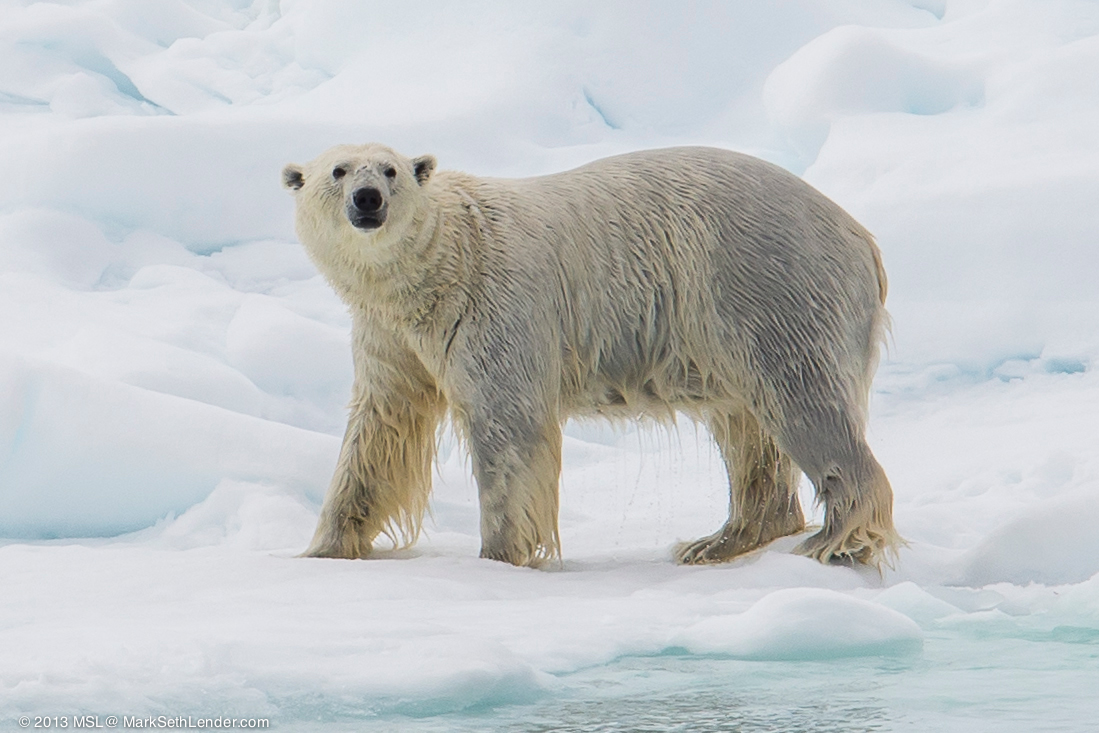
(Mark Seth Lender)
CURWOOD: To see Mark’s photos of that swimming polar bear and to follow his arctic blog, take the plunge, and head on over to our website at LOE.org.
Related links:
- Canadian Tourism Commission
- Adventure Canada
[MUSIC: Marc Johnson-Elias “Swept Away” from Swept Away (ECM Records 2013)]
Coming up...how city parks helped launch one of the biggest trends in popular music. Stay tuned to Living on Earth.
[CUTAWAY MUSIC: Pat Metheny: “So May It Secretly Begin” from Still Life (Talking) (Geffen Records 1987)]
ANNOUNCER: Funding for Living on Earth comes from the Grantham Foundation for the protection of the environment, supporting strategic communications and collaboration in solving the world’s most pressing environmental problems. The Kendeda Fund, furthering the values that contribute to a healthy planet. And Gilman Ordway for the coverage of conservation and environmental change. This is PRI, Public Radio International.
Hip Hop Born in the Parks
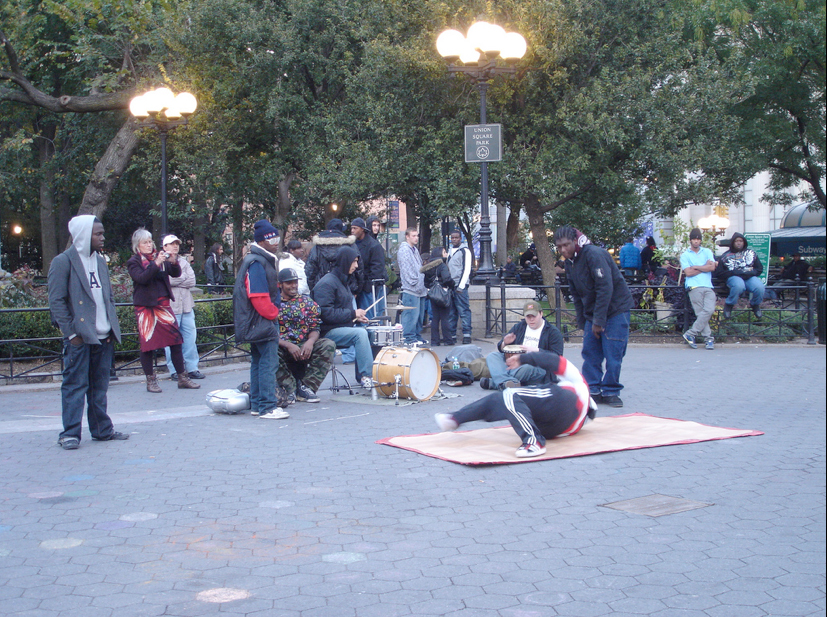
Hip Hop music got an early boost in Union Square Park in Manhattan. (G. Wu)
CURWOOD: It's Living On Earth, I'm Steve Curwood.
[MUSIC: DJ Jazzy Jef & The Fresh Prince “Summertime” from The Very Best Of DJ Jazzy Jeff & The Fresh Prince (Zomba Records 1997)]
CURWOOD: Ahhh, summertime! For people in the country or suburbs that might mean heading to the lake or a barbecue in the back yard. But for folks that live in urban areas, the city park is often the best place to get together.
[MUSIC: DJ Jazzy Jef & The Fresh Prince “Summertime” from The Very Best Of DJ Jazzy Jeff & The Fresh Prince (Zomba Records 1997)]
CURWOOD: Now the biophilia hypothesis argues that people become more creative in green spaces, and one bit of evidence may be the combination of spoken poetry and infectious beat known as hip hop music. Hip hop got its start as a genre in urban parks, as Will Smith’s 1992 hit Summertime reflects. At least, that’s the take of Grist magazine contributor Ben Adler.
ADLER: Will Smith is from West Philladelphia and of course Philly has some great parks, Fairmont Park being the most famous. I mean, Summertime really is a classic. He’s talking about the positive sides of the urban experience of parks. People in cities, they don’t go away for the whole summer, they don’t go to sleepaway camp with their children, they go to the parks. He’s presenting that in this very joyful way. These are the joys of summer, playing ball, having barbecues. It’s a place to meet girls and it’s sort of the epitome of the summer jam.
CURWOOD: So tell me, what are the roots of hip hop?
ADLER: Well, hip hop was born in the South Bronx in public housing projects. It’s party music. Parties and deejays - if you’ve ever been to a Bar Mitzvah, you’ve observed that parties often have deejays - and the deejays often act as emcees, masters of ceremonies, with a microphone. And they encourage people to get out on the dance floor, right? Hip hop came out of those kinds of parties. There was immigration from Jamaica, and there were Jamaican deejays who brought some of the deejaying traditions from there to the African American community in New York City. And they started mixing records, and the master of ceremonies, the emcee, would sort of joke around, and talk gibberish on the microphone, you know, ‘hip to the hop, you don’t stop’, kind of thing. And hip hop came out of those kinds of parties. Big parties held in like a rec room of a public housing project and parks where people could gather, people who didn’t have money, people who weren’t of age to go to a place where you have to pay to get into, like a bar, or have an ID to get into. Mostly famously, Manhattan’s Union Square Park, that is really where hip hop was invented and developed and came up.
CURWOOD: Yes. Let’s listen to hip hop song that talks about that early scene. This is MC Shan from 1988.
[MUSIC: MC Shan “They Used To Do It Out In The Park”]
ADLER: One of the really interesting thing about hip hop from the late ’80s is that that’s what we call old school now. It sounds so primitive. It was already, you know, a decade after it started to break out. And already you had nostalgia, songs about how the heyday of park jams was already over. The park was where hip hop was made. MC Shan was a really important figure in the development of hip hop; he was the main emcee in the Queens-based Juice Crew, and he had a rivalry with KRS-One. At the time, MC Shan was bigger, but KRS-One really went out to eclipse him to become a hugely legendary figure.
CURWOOD: Well, let’s listen this tune called Outta Here by KRS-One.
[MUSIC: KRS-One: “Outta Here” from The return Of Boom Bap (Zomba Records 1992)]
CURWOOD: KRS-One; tell me more about his story.
ADLER: KRS-One grew up partly in Brooklyn and partly in the Bronx. When his family was living in Brooklyn, as a teenager, he ran away from home. He was homeless, and he slept in public parks. He ended up in a homeless shelter in the Bronx where DJ Scott La Rock was a youth counselor. And the two of them got together and started making hip hop music. But after Scott La Rock was killed, KRS-One adopted a socially conscious, progressive world view. He went on to embrace feminism and vegetarianism. KRS-One, because he was sleeping out in the parks, that’s where the park jams were happening.
CURWOOD: Hey. The last song I want you to talk about, Ben, is Arrested Development’s People Everyday. This song takes place entirely in a park.
[MUSIC: Arrested Development “People Everyday” from 3 Years, 5 Months And 2 Days in the Life Of…(Capitol Records 1992)]
CURWOOD: What’s the message behind this song?
ADLER: Arrested Development had this style that was, you know, they wore this sort of African inspired clothes and Speech the emcee wore glasses. And it was very overtly Afro-centric and overtly intellectual, and they make this song about just a sort of typical day which Speech describes himself as a fashion misfit. He’s hanging out at the park. It’s a beautiful day. He sees his girlfriend, and then a group of men who are drinking, they start harassing his girlfriend, and it ends in a fight between him and one of the men, but it’s not celebrating that’s what happens, it’s decrying it. It’s an overt plea for mutual respect in the community.
CURWOOD: So what do you expect going forward now in terms of music inspired by parks and public space?
ADLER: Unfortunately, I think mainstream hip hop for the last maybe 15 years has been dominated by corporate commercial acts, that they’re often from these really kind of suburban cities where parks play less of a role. So the setting for songs is in cars. You could say it’s not as ecologically friendly of a sort of setting. The connection between hip hop and parks had a lot to do early on with its roots in New York City. Commercial mainstream hip hop has sort of been taken over and ruined by the suburbs, like most everything else in this country.
CURWOOD: Thanks so much, Ben.
ADLER: Thank you.
CURWOOD: Ben Adler is Managing Editor of YearsOfLivingDangerously.com and a frequent contributor to Grist.
Related links:
- (Content and language may not be appropriate for young listners)
-
-
-
- Read Ben Adler’s Piece in Grist
Recording Nature By Sound
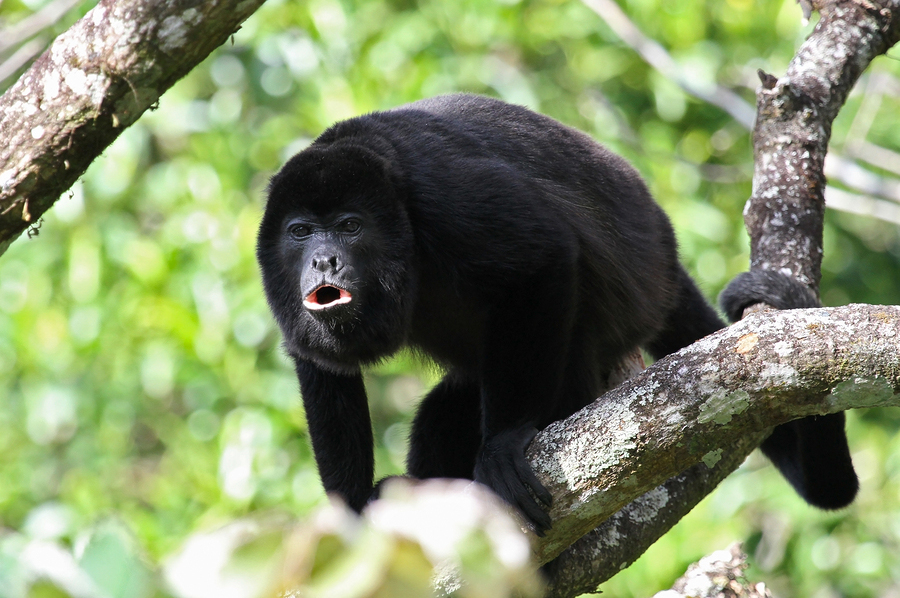
Howler monkeys are a part of the sound scape in Costa Rica’s La Selva Rainforest. (bigstockphotos.com)
CURWOOD: A healthy forest, especially in the tropics, is a noisy place.
[FOREST SOUNDS]
CURWOOD: There’s always something going on - insects buzzing, frogs peeping, birds calling to one another. This audio snap shot comes from El Verde field station in El Yunque National Forest, Puerto Rico, and is part of a new way to capture the sounds of nature known as the Automated Remote Biodiversity Monitoring Network. Mitch Aide is a professor of biology and tropical ecology at the University of Puerto Rico and a lead researcher on the project. He says to create a sonic fingerprint of a natural spot, the network records for a minute at a time, every ten minutes.
AIDE: What we’re doing is just putting microphones out in the field connected to an iPod, and we’ve developed an application that automates the collection of sound. The new part was that we moved the sounds from the field to the internet, and then provide them for people to visualize and listen to on the internet virtually in real time.
AIDE: So how much sound do you get?
CURWOOD: We’re capturing the whole soundscape, everything that’s making noise at a time. So we’re capturing the animals, the rain, the wind, an airplane flying over. We’re here in Puerto Rico where you can have a car drive by and you can hear the music or Reggaeton playing sometimes.

Rainforests are a particularly noisy place. (bigstockphoto.com))
[LAUGHS]
CURWOOD: So this has got to be hours and hours and hours and hours of tape.
AIDE: Yes. That’s where the second part of the project comes in, and that’s the software part. And we’ve developed a software that allows the user to produce a model that allows them to then analyze all of their data. So they can go in and produce a model for a specific song for a specific species, and that allows the computer to do the hard work and listen to hundreds of thousands of recordings.
CURWOOD: Well, let’s listen to one. We have one from Sabana Seca you sent us from Puerto Rico. It’s from July 7, 2013. Let’s take a listen.
[HIGH PITCHED CHIRPING]
AIDE: In Sabana Seca, we established a permanent station there because there was a new species of frog, a coquí. It’s called the Plains coquí. It was discovered about six or seven years ago, and, of course, there wasn’t much information on this species. So that’s one of the reasons we decided to put a permanent station there. Now we have over 200,000 recordings of this species, but in that particular recording that you’re hearing, there are at least four other species of frogs that are calling at the same time.
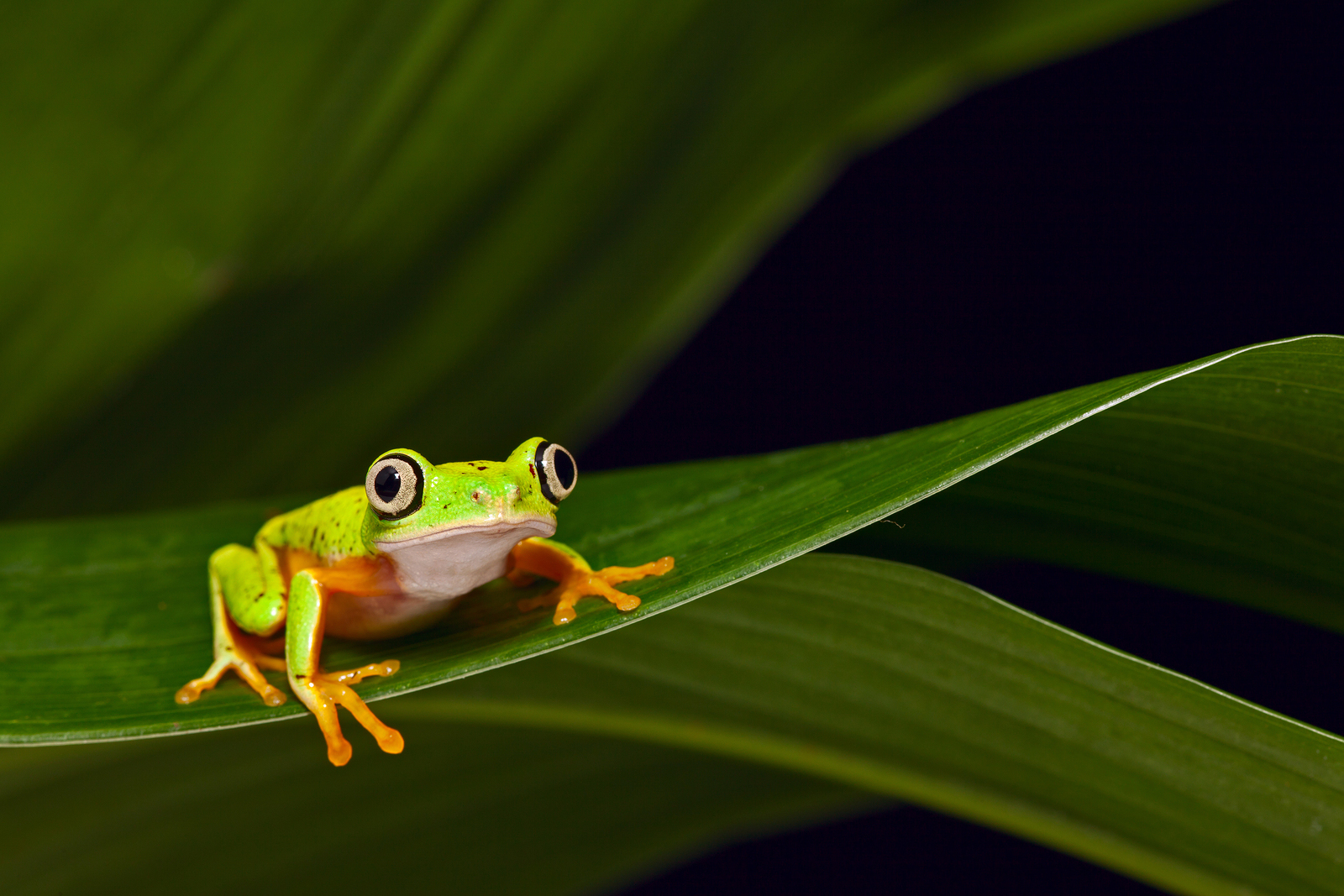
A yellow tree frog. (bigstockphoto.com)
CURWOOD: Now the coquí, this is the iconic animal in Puerto Rico.
AIDE: Yes. Coquí is the genus. There are around 14 species of coquí, and now with this new species, there’s one more to listen to. Each one of them has their own unique call. That’s why we can hear four, five of them at the same time in the same recording because there’s no overlap in the frequency that they’re using.
CURWOOD: Here’s another one. This is from Cabo Frio in Brazil.
[UNIQUE BIRD CALL]
CURWOOD: Professor, that recording is being labeled as part of the Biological Dynamics of Forest Fragments Project. Can you tell me about that project?
AIDE: Sure. This is a project that is organized by Gonzalo Fairdos, he’s a professor in Brazil. And Gonzalo along with his students are studying over 150 species of understory birds. They’re sampling many, many places within the Amazon forest. They had over 200,000 recordings and the software has helped them to organize them and begin creating models for some of those 150 species of birds they’re studying.
CURWOOD: As I understand it, you have over a million recordings by now. What are you doing with all that sound? How do biologists use this information?
AIDE: Each one of these recordings is virtually equivalent of a museum specimen. Today what most of the people that are using the system, they’re using it to create models to look at long-term change in populations. And one of the nice things about using sound is that it captures many of the species that are calling in a site at a time. And so one of the things that this allows us to do is follow the acoustics of a site over many, many years to see how species are coming or going, or how populations are declining across time with changes in climate change or habitat degradation.
CURWOOD: I’ve read that in Indonesia researchers are using a similar technology. They use that though to identify the sound of chainsaws so they can alert authorities to illegal logging. I wonder if you’ve considered that.
AIDE: No, but it doesn’t surprise me. Chainsaws, gunfire, all have characteristic sounds, and if you have enough examples, you can create these models that automate the identification and be able to alert the researcher, or the authorities in the case in Southeast Asia.
CURWOOD: So let’s take a listen to some more now. This is from La Selva Rainforest in Costa Rica.
[MONKEYS IN THE WILDERNESS]
CURWOOD: So, what are those sounds at the end? It kind of sounds like a dog barking.
AIDE: No, it’s probably a Howler monkey. The males will call early in the morning, late at night if they’re disturbed or even when a storm starts rolling you can hear the Howler monkeys calling from over a kilometer or two away.
CURWOOD: Now you have recordings from six different countries - all of these are in Latin America. Where do you want to go next with the technology?
AIDE: We’d love to expand this around the world. The project was initially funded by the National Science Foundation. And it was really done as a proof of concept. We’ve accomplished that part. And now we’re hoping that the attention the project is getting will help us get more funds so that we can put this in many, many sites in national parks, areas that are being rapidly changed, all around the world.
CURWOOD: Mitch Aide is a professor of biology and tropical ecology at the University of Puerto Rico, Rio Piedras. Thank you so much for taking the time today.
AIDE: Thank you, Steve.
Related links:
- Automated Remote Biodiversity Monitoring Network
- More about Mitch Aide
[MUSIC: BIRD NOTE® THEME]
BirdNote® All That Jazz

Mallards Skating (© Jennifer Tomaloff)
CURWOOD: Edward Elgar had a habit of walking in the woods round his home in England's west midlands when he was composing. Famously he exclaimed: "The trees are singing my music!" And he wasn't the only composer to look to the natural world for help and ideas. Here's Mary McCann with our BirdNote®.
MCCANN: Birds are an inspiration for many musicians.
[MUSIC: THE PENGUIN]

Gentoo Penguins (© Sean Oneill)
Bandleader Raymond Scott probably saw these birds at the Central Park Zoo before writing his waddling 1937 hit “The Penguin.”
[GENTOO PENGUIN]
All penguins are clumsy on land but these Gentoos are superlative swimmers - the fastest of any diving bird - reaching 22 miles an hour, and diving to 600 feet.
[MALLARDS QUACKING]
Speaking of swimmers, Brazilian composer Joao Gilberto has swans, geese and ducks doing the samba in his song “O Pato,” or “The Duck,” sung here by Karrin Allysson.
[MUSIC: O PATO]
Jazz musicians improvise on a theme, and Dave Brubeck, who grew up in the West, undoubtedly heard the Western Meadlowlark
[WESTERN MEADOWLARK]

Western Meadowlark in full song. (© Tom Grey)
before writing “Strange Meadowlark.” The tune appeared on Brubeck’s legendary 1959 release “Time Out.”
[MUSIC: Dave Brubeck “Strange Meadow Lark” from Time Out (Columbia Records 1997 Reissue)]
I’m Mary McCann.
CURWOOD: To see some photos of penguins and meadowlarks and ducks, waddle on down to our website LOE.org.
[Jazz composers paint pictures in music of some favorite birds.]
Related link:
BirdNote®
CURWOOD: Living on Earth is produced by the World Media Foundation. Naomi Arenberg, Bobby Bascomb, Emmett Fitzgerald, Helen Palmer, Poncie Rutsch, Erin Weeks, Adelaide Chen, James Curwood, Jennifer Marquis and Gabriela Romanow all help to make our show. Jeff Turton is our technical director. Alison Lirish Dean composed our themes. You can find us anytime at LOE.org. And check out our Facebook page - it’s PRI’s Living on Earth. And we tweet from @LivingOnEarth. I'm Steve Curwood. Thanks for listening.
ANNOUNCER1: Funding for Living on Earth comes from the Grantham Foundation for the protection of the environment, supporting strategic communications and collaboration in solving the world’s most pressing environmental problems. The Kendeda Fund, furthering the values that contribute to a healthy planet and Gilman Ordway for coverage of conservation and environmental change. Living on Earth is also supported by a friend of Red Tomato, supplier of rightous fruits and vegetables from Northeast family farms. www.redtomato.org. This is PRI, Public Radio International.
ANNOUNCER2: PRI. Public Radio International.
Living on Earth wants to hear from you!
Living on Earth
62 Calef Highway, Suite 212
Lee, NH 03861
Telephone: 617-287-4121
E-mail: comments@loe.org
Newsletter [Click here]
Donate to Living on Earth!
Living on Earth is an independent media program and relies entirely on contributions from listeners and institutions supporting public service. Please donate now to preserve an independent environmental voice.
NewsletterLiving on Earth offers a weekly delivery of the show's rundown to your mailbox. Sign up for our newsletter today!
 Sailors For The Sea: Be the change you want to sea.
Sailors For The Sea: Be the change you want to sea.
 The Grantham Foundation for the Protection of the Environment: Committed to protecting and improving the health of the global environment.
The Grantham Foundation for the Protection of the Environment: Committed to protecting and improving the health of the global environment.
 Contribute to Living on Earth and receive, as our gift to you, an archival print of one of Mark Seth Lender's extraordinary wildlife photographs. Follow the link to see Mark's current collection of photographs.
Contribute to Living on Earth and receive, as our gift to you, an archival print of one of Mark Seth Lender's extraordinary wildlife photographs. Follow the link to see Mark's current collection of photographs.
 Buy a signed copy of Mark Seth Lender's book Smeagull the Seagull & support Living on Earth
Buy a signed copy of Mark Seth Lender's book Smeagull the Seagull & support Living on Earth

